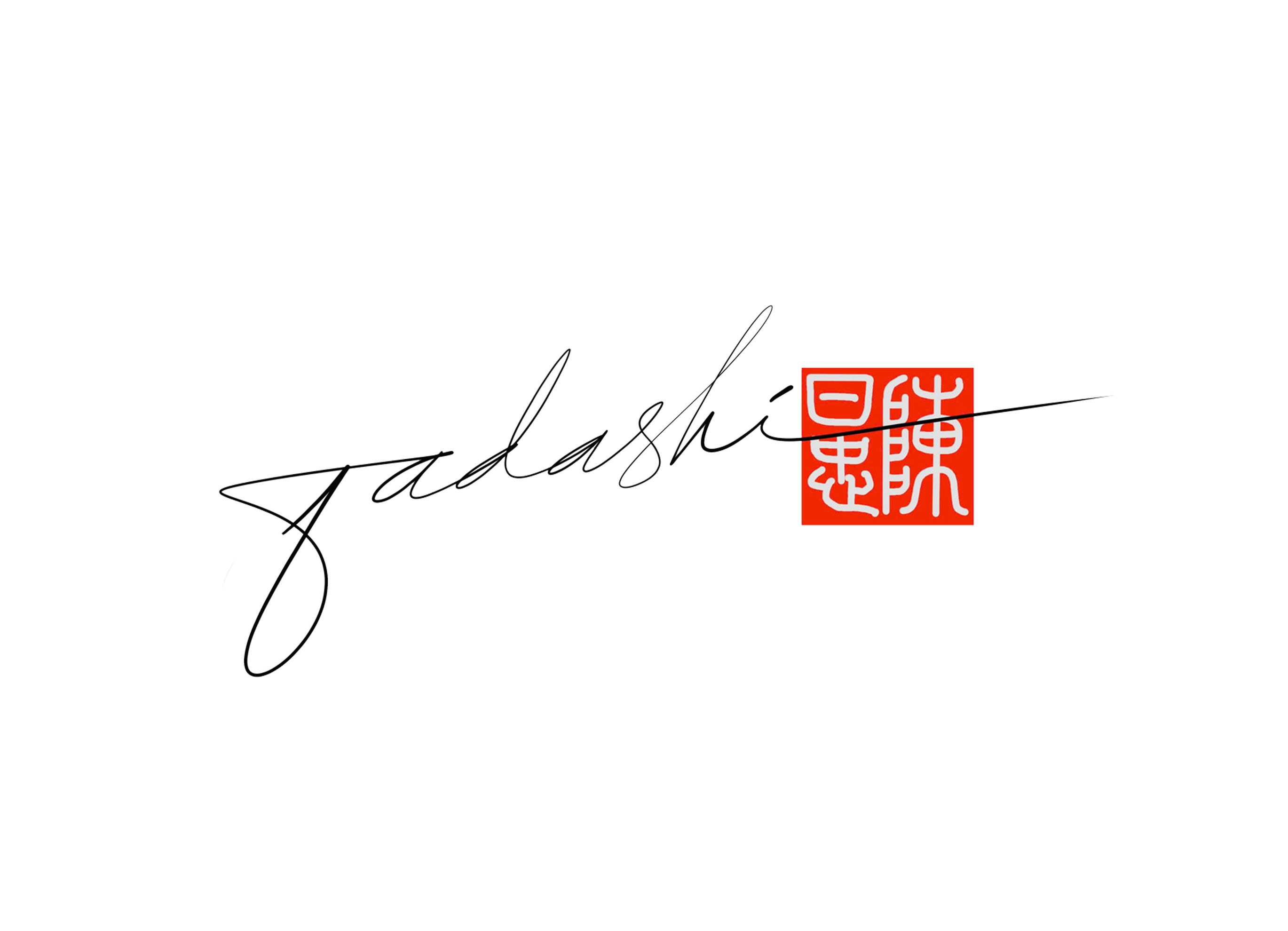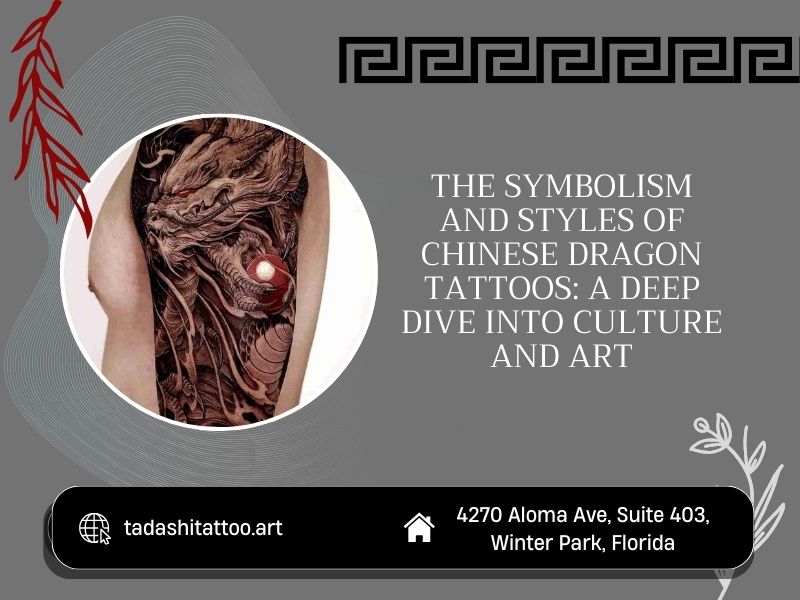Chinese dragon tattoos are not just visually stunning works of art; they are powerful symbols deeply rooted in myth and culture. Unlike their aggressive Western counterparts, these creatures are revered as wise and benevolent beings. Choosing a Chinese dragon tattoo is a way to embrace qualities like strength, power, prosperity, and good fortune, making each design a personal talisman.
1. What Do Chinese Dragon Tattoos Mean?
A Chinese dragon tattoo is a powerful and popular choice, carrying deep and multifaceted symbolism that is significantly different from Western dragons. While Western dragons are often seen as malevolent, fire-breathing beasts, Chinese dragons are revered as benevolent, wise, and auspicious creatures.
Here is a breakdown of the key meanings associated with a Chinese dragon tattoo:
1.1. Core Symbolism
- Strength, Power, and Authority: The dragon is the ultimate symbol of power in Chinese culture. Historically, it was the exclusive symbol of the emperor, representing supreme authority and nobility.
- Wisdom and Good Fortune: Dragons are considered to be keepers of ancient knowledge and spiritual energy. They are believed to bring prosperity, luck, and success to those who are worthy.
- Protection and Spiritual Power: Chinese dragons are seen as protectors, warding off evil spirits and bringing good luck. They are often associated with the elements and are said to have control over water, rain, typhoons, and floods.
- Longevity and Immortality: The dragon can represent the cycle of life and immortality.
- Yang and Masculinity: The dragon embodies the concept of “yang,” representing positive, active, and masculine energy.
- Transformation: Dragons are mythical beings with the ability to transform, which can symbolize personal change and growth.
1.2. Symbolism Based on Design Elements
- The Number of Claws: This is a crucial detail. In Chinese culture, a five-clawed dragon was reserved exclusively for the emperor. A three-clawed dragon is more common in Japanese art, while a four-clawed dragon is often chosen for tattoos today. A three-clawed dragon can sometimes be associated with gang-related imagery, so it’s a good idea to research this with your artist.
- The Flaming Pearl: Often depicted under the dragon’s chin or in its claws, the pearl can represent spiritual energy, wisdom, prosperity, or power. It is said that the pearl grants the dragon total wisdom.
- Color: The color of the dragon can add a specific layer of meaning:
- Yellow/Golden: Represents the imperial family, wealth, wisdom, and good fortune.
- Red: Symbolizes good fortune, happiness, passion, and power.
- Blue: Associated with wisdom, compassion, and spiritual healing.
- Black: Can represent wisdom, power, and protection, but can also be associated with vengeance.

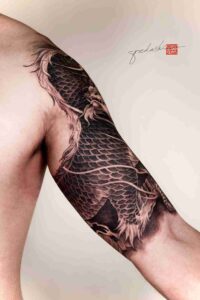
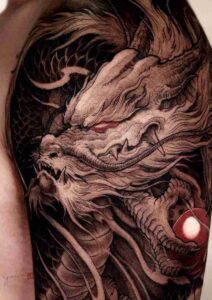
2. Chinese Dragon Tattoo Ideas
Looking for ideas for a Chinese dragon tattoo? Here’s a curated list covering everything from legendary types to symbolic designs and where on your body they might look best.
2.1. Mythical Dragon Concepts
- Tianlong (Heavenly Dragon): If you’re drawn to a divine, protective symbol, the Tianlong is the guardian of the heavens and a perfect choice.
- Shenlong (Spiritual Dragon): This is the master of wind and rain. A tattoo of this dragon could feature powerful swirls of clouds and water to represent control over nature and great change.
- Fuzanglong (Treasure Dragon): Imagine this dragon coiled protectively around a hoard of jewels or treasure—a powerful symbol of wealth and abundance.
- Horned Dragon: As the most formidable type, a horned dragon tattoo is for those who want to project immense authority and raw power.
2.2. Symbolic Designs with Deep Meaning
- Dragon and Pearl: The dragon’s pearl can represent a multitude of things, including spiritual energy, profound wisdom, or prosperity. A popular design shows the dragon either holding the pearl in its claws or in a dynamic chase.
- Dragon and Phoenix: This timeless pair represents the ultimate balance of yin and yang. It’s an ideal way to symbolize a harmonious relationship or a complementary partnership.
- Dragon and Koi Fish: This design tells a story of perseverance. Based on the legend of a koi transforming into a dragon, it’s a powerful symbol of determination and destiny, often inked on a sleeve or back with the koi swimming upstream.
- Yin Yang Dragons: Two dragons—one black, one white—chase each other in a circle, creating the classic yin yang symbol. It beautifully represents the harmony of opposite forces.
- Dragon and Tiger: For a visual representation of the duality between spirit and body, or the clash between wisdom (the dragon) and raw might (the tiger), a design showing these two mythical beasts in conflict is a striking choice.
2.3. Stylistic and Placement Considerations
- Gold Dragon: Traditionally reserved for emperors, a golden dragon signifies immense power, wealth, and royal compassion.
- Water Dragon: To capture the traditional Chinese dragon’s connection to water, an elegant design of the dragon gracefully weaving through waves makes a compelling statement.
- Five-Claw Dragon: The number of claws is significant. A five-clawed dragon is a symbol of royalty and good fortune.
- Minimalist Dragon: For a more subtle look, a minimalist design uses clean lines to capture the essence of the dragon.
- Black and White Dragon: This classic, high-contrast style is perfect for highlighting the intricate details of the dragon’s scales and form.
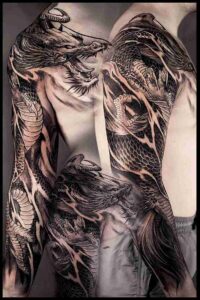

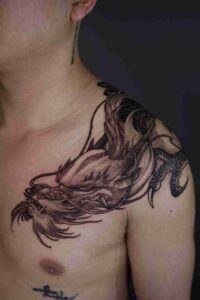
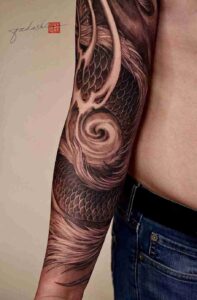
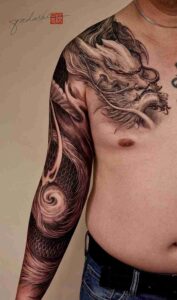
3. Where Should I Put My Tattoo?
The ideal spot for your Chinese dragon tattoo is determined by the design’s size, style, and your personal meaning. The dragon’s fluid, lengthy form is well-suited to follow the body’s natural lines.
3.1. For Large-Scale Designs
For complex, detailed dragon pieces, expansive areas are optimal.
- Back: A full-back piece is a popular, powerful option, providing maximum space for a detailed design and symbolizing strength and protection.
- Sleeve: A dragon can be expertly coiled around the arm for a full or half-sleeve, emphasizing its graceful form.
- Chest: A chest tattoo is a bold statement of courage and internal power.
- Leg (Thigh or Calf): Legs offer a large canvas for intricate designs that are easy to either display or conceal. The thigh is often chosen for its larger surface area and comfort during the tattooing process.
3.2. For Smaller, Finer Designs
If you want a minimalist or discreet look, consider these smaller areas.
- Forearm/Bicep: These are highly visible and great for showcasing smaller, impactful designs like a dragon’s head or coiled body.
- Wrist or Ankle: A delicate, small dragon can be wrapped around these areas for a subtle, elegant touch.
- Behind the Ear: A tiny, snake-like dragon in this spot is both discreet and graceful.

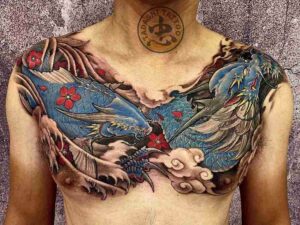
Final Words
When considering your final design, remember that traditional beliefs around Feng Shui play a key role in the dragon’s symbolism. Beyond just the style or placement on your body, the direction of the dragon itself holds significant meaning. A dragon depicted flying upward is considered highly auspicious, representing spiritual growth, career success, and the fulfillment of your ambitions. This is the most common and widely recommended direction for those seeking good fortune.
Conversely, a dragon facing downward is often viewed as a negative omen. Therefore, choosing a dragon that ascends can align your tattoo with positive energy and forward momentum, making it a powerful and meaningful symbol.
